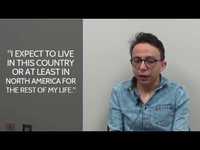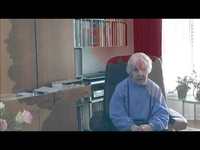Items
Tag
Adaptation to Canada
-
 Colombia to Canada: A journey of self discovery and cultural identity. In this video, Emilio Borja discusses his journey with his cultural identity. Borja discusses topics such as his life before Canada, his reasons for coming to Canada, what he misses about Colombia, and what he likes about life in Canada. All these topics build up to Borja’s discussion of cultural identity. Borja tells us what he feels his personal cultural identity is and explains why he feels this way. Borja then explains his definition of cultural identity, and how he believes cultural identity is fluid and able to change over time. He also explains why he feels this fluidity can be both good and bad.
Colombia to Canada: A journey of self discovery and cultural identity. In this video, Emilio Borja discusses his journey with his cultural identity. Borja discusses topics such as his life before Canada, his reasons for coming to Canada, what he misses about Colombia, and what he likes about life in Canada. All these topics build up to Borja’s discussion of cultural identity. Borja tells us what he feels his personal cultural identity is and explains why he feels this way. Borja then explains his definition of cultural identity, and how he believes cultural identity is fluid and able to change over time. He also explains why he feels this fluidity can be both good and bad. -
 Creating Identity through Music This portrait demonstrates through various music clips, the integration of music and the importance in my partners life. Through being from a family of doctor’s in Havana, being the only musician enabled him to attend school for “free” in Cuba after being 1 of 6 chosen. Through participating in a program that enables him to arrive in Canada, and for a fee that is to be paid back to the government, is able to play concerts in Canada. He speaks about how the connection of music amongst different composers, no matter the sound or instrument, is a family and a connected language. He represents his identity through the constant listening and incorporating of music into his saxophone, drums, and piano gigs, alongside dj’ing at various clubs within London. Through tailoring his music towards the cultural crowd, and being able to adapt and fit in with the crowd with unique and current songs, brings forward the ability for various cultural groups to feel connected through the language of music. A universal language.
Creating Identity through Music This portrait demonstrates through various music clips, the integration of music and the importance in my partners life. Through being from a family of doctor’s in Havana, being the only musician enabled him to attend school for “free” in Cuba after being 1 of 6 chosen. Through participating in a program that enables him to arrive in Canada, and for a fee that is to be paid back to the government, is able to play concerts in Canada. He speaks about how the connection of music amongst different composers, no matter the sound or instrument, is a family and a connected language. He represents his identity through the constant listening and incorporating of music into his saxophone, drums, and piano gigs, alongside dj’ing at various clubs within London. Through tailoring his music towards the cultural crowd, and being able to adapt and fit in with the crowd with unique and current songs, brings forward the ability for various cultural groups to feel connected through the language of music. A universal language. -
 Integrating Japanese Culture into Canada In this portrait, Keiko Yano talks about the different aspects of the Japanese culture being adapted to Canada such as Girl’s Day and tea ceremony. She explains her participation in the community and her wish to keep the culture alive within her daughters. Keiko’s daughter, Erika, then briefly explains why she continues to learn the Japanese language. After that Keiko’s husband, Chris, describes the significance of Buddhism practices to him and discusses the activeness of the Japanese community in London. The portrait then ends with Keiko expressing her renewal of self and deeper appreciation in the Japanese culture by coming to Canada.
Integrating Japanese Culture into Canada In this portrait, Keiko Yano talks about the different aspects of the Japanese culture being adapted to Canada such as Girl’s Day and tea ceremony. She explains her participation in the community and her wish to keep the culture alive within her daughters. Keiko’s daughter, Erika, then briefly explains why she continues to learn the Japanese language. After that Keiko’s husband, Chris, describes the significance of Buddhism practices to him and discusses the activeness of the Japanese community in London. The portrait then ends with Keiko expressing her renewal of self and deeper appreciation in the Japanese culture by coming to Canada. -
 Home in Canada: Immigrant from Germany to Canada in 1980s Reinhild came from Chemnitz, Germany. She immigrated with her family to Canada in the 1980s. She taught mathematics in Western before. This video will introduce her immigrant process and the factors she thinks affect her integrated into Canada.
Home in Canada: Immigrant from Germany to Canada in 1980s Reinhild came from Chemnitz, Germany. She immigrated with her family to Canada in the 1980s. She taught mathematics in Western before. This video will introduce her immigrant process and the factors she thinks affect her integrated into Canada.